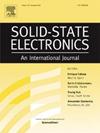Source/drain metal-dependent oxygen scavenging from the viewpoint of the decoupling between source/drain resistance and threshold voltage in InGaZnO thin-film transistors
IF 1.4
4区 物理与天体物理
Q3 ENGINEERING, ELECTRICAL & ELECTRONIC
引用次数: 0
Abstract
Reducing source-drain resistance (RSD) in oxide semiconductor thin-film transistors (TFTs) mainly impacts the performance and reliability of devices and circuits. Oxygen scavenging (OS) is commonly used during process integration to reduce RSD, including contact resistance between source-drain (S/D) metal and oxide semiconductors. Meanwhile, the lower RSD, the better, but the threshold voltage (VT) should be optimized depending on the application. Therefore, it is essential to decouple RSD and VT when applying OS.
In this study, the OS effect depending on the S/D metal of amorphous InGaZnO (a-IGZO) TFT was investigated from the perspective of decoupling RSD and VT. As a result of comparing Cu, Ti, and Al as S/D metals, when Al, which has a high metal–oxygen (M−O) bond strength, was used as the source-drain metal, VT and RSD decreased and on-current (Ion) increased compared to when Ti was used. A comprehensive analysis of TFT’s electrical characteristics (VT, mobility, Ion), X-ray photoelectron spectroscopy (XPS), subgap density of states (DoS), and lateral distribution of thermal equilibrium carrier concentration (n0(y)) indicates that the occurrence and diffusion of oxygen vacancy (VO) due to OS in the S/D region cause an increase in subgap DoS and gate-to-S/D overlap length (LOV) and a decrease in VT due to an increase in donor concentration in the center of the channel (NCH) due to a change in n0(y) profile.
While RSD changes before and after post-annealing are ×1.087 (Cu), ×0.606 (Ti), and ×0.283 (Al), NCH changes are ×0.985 (Cu), ×1.267 (Al), and ×1.183 (Ti). The ΔVT’s before and after post-annealing are + 0.119 V (Cu), −0.206 V (Al), and − 0.045 V (Ti), while ΔIon’s are ×0.724 (Cu), ×1.222 (Al), and ×1.193 (Ti). Therefore, it is found that Ti is more advantageous than Al in terms of decoupling RSD and VT.
Our result becomes more critical in employing oxide semiconductor TFTs as the back end of line (BEOL) devices because the phenomenon of VT being affected in improving RSD using OS can become more severe in high-temperature processes. Furthermore, our result suggests that when selecting S/D metals and annealing conditions for OS, it is necessary to fully consider not only the RSD reduction but also the degree to which RSD and VT can be decoupled.
从InGaZnO薄膜晶体管源/漏极电阻和阈值电压去耦的角度看源/漏极金属依赖的氧清除
降低氧化物半导体薄膜晶体管(TFTs)的源漏电阻(RSD)主要影响器件和电路的性能和可靠性。氧清除(OS)通常用于工艺集成过程中,以降低RSD,包括源漏(S/D)金属和氧化物半导体之间的接触电阻。同时,RSD越低越好,但阈值电压(VT)应根据应用进行优化。因此,在应用OS时解耦RSD和VT是必要的。本研究从RSD和VT解耦合的角度研究了非晶InGaZnO (a- igzo) TFT的OS对S/D金属的影响。通过比较Cu、Ti和Al作为S/D金属,当Al作为源-漏金属时,与Ti相比,具有高金属-氧(M−O)结合强度的Al作为源-漏金属时,VT和RSD降低,导通电流(Ion)增加。综合分析了TFT的电学特性(VT、迁移率、离子)、x射线光电子能谱(XPS)、子隙态密度(DoS)、和热平衡载流子浓度(n0(y))的横向分布表明,氧空位(VO)在S/D区域的发生和扩散导致子隙DoS和栅极-S/D重叠长度(LOV)的增加,而由于n0(y)分布的变化导致通道中心供体浓度(NCH)的增加而导致VT的降低。退火前后RSD变化分别为×1.087 (Cu)、×0.606 (Ti)和×0.283 (Al), NCH变化分别为×0.985 (Cu)、×1.267 (Al)和×1.183 (Ti)。退火前后的ΔVT分别为+ 0.119 V (Cu)、−0.206 V (Al)和−0.045 V (Ti), ΔIon分别为×0.724 (Cu)、×1.222 (Al)和×1.193 (Ti)。因此,我们发现Ti在去耦RSD和VT方面比Al更有利。我们的结果对于使用氧化物半导体TFTs作为后端线(BEOL)器件变得更加关键,因为使用OS改善RSD时VT受到影响的现象在高温过程中会变得更加严重。此外,我们的结果表明,在选择S/D金属和OS的退火条件时,不仅需要充分考虑RSD的降低,还需要充分考虑RSD和VT可以解耦的程度。
本文章由计算机程序翻译,如有差异,请以英文原文为准。
求助全文
约1分钟内获得全文
求助全文
来源期刊

Solid-state Electronics
物理-工程:电子与电气
CiteScore
3.00
自引率
5.90%
发文量
212
审稿时长
3 months
期刊介绍:
It is the aim of this journal to bring together in one publication outstanding papers reporting new and original work in the following areas: (1) applications of solid-state physics and technology to electronics and optoelectronics, including theory and device design; (2) optical, electrical, morphological characterization techniques and parameter extraction of devices; (3) fabrication of semiconductor devices, and also device-related materials growth, measurement and evaluation; (4) the physics and modeling of submicron and nanoscale microelectronic and optoelectronic devices, including processing, measurement, and performance evaluation; (5) applications of numerical methods to the modeling and simulation of solid-state devices and processes; and (6) nanoscale electronic and optoelectronic devices, photovoltaics, sensors, and MEMS based on semiconductor and alternative electronic materials; (7) synthesis and electrooptical properties of materials for novel devices.
 求助内容:
求助内容: 应助结果提醒方式:
应助结果提醒方式:


